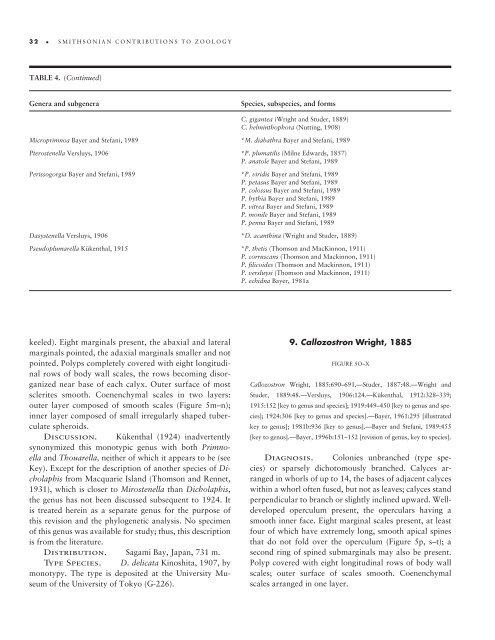A Generic Revision and Phylogenetic Analysis of the Primnoidae
A Generic Revision and Phylogenetic Analysis of the Primnoidae
A Generic Revision and Phylogenetic Analysis of the Primnoidae
Create successful ePaper yourself
Turn your PDF publications into a flip-book with our unique Google optimized e-Paper software.
32 SMITHSONIAN CONTRIBUTIONS TO ZOOLOGY<br />
TABLE 4. (Continued)<br />
Genera <strong>and</strong> subgenera Species, subspecies, <strong>and</strong> forms<br />
keeled). Eight marginals present, <strong>the</strong> abaxial <strong>and</strong> lateral<br />
marginals pointed, <strong>the</strong> adaxial marginals smaller <strong>and</strong> not<br />
pointed. Polyps completely covered with eight longitudinal<br />
rows <strong>of</strong> body wall scales, <strong>the</strong> rows becoming disorganized<br />
near base <strong>of</strong> each calyx. Outer surface <strong>of</strong> most<br />
sclerites smooth. Coenenchymal scales in two layers:<br />
outer layer composed <strong>of</strong> smooth scales (Figure 5m–n);<br />
inner layer composed <strong>of</strong> small irregularly shaped tuberculate<br />
spheroids.<br />
Discussion. Kükenthal (1924) inadvertently<br />
synonymized this monotypic genus with both Primnoella<br />
<strong>and</strong> Thouarella, nei<strong>the</strong>r <strong>of</strong> which it appears to be (see<br />
Key). Except for <strong>the</strong> description <strong>of</strong> ano<strong>the</strong>r species <strong>of</strong> Dicholaphis<br />
from Macquarie Isl<strong>and</strong> (Thomson <strong>and</strong> Rennet,<br />
1931), which is closer to Mirostenella than Dicholaphis,<br />
<strong>the</strong> genus has not been discussed subsequent to 1924. It<br />
is treated herein as a separate genus for <strong>the</strong> purpose <strong>of</strong><br />
this revision <strong>and</strong> <strong>the</strong> phylogenetic analysis. No specimen<br />
<strong>of</strong> this genus was available for study; thus, this description<br />
is from <strong>the</strong> literature.<br />
Distribution. Sagami Bay, Japan, 731 m.<br />
Type Species. D. delicata Kinoshita, 1907, by<br />
monotypy. The type is deposited at <strong>the</strong> University Museum<br />
<strong>of</strong> <strong>the</strong> University <strong>of</strong> Tokyo (G-226).<br />
C. gigantea (Wright <strong>and</strong> Studer, 1889)<br />
C. helminthophora (Nutting, 1908)<br />
Microprimnoa Bayer <strong>and</strong> Stefani, 1989 *M. diabathra Bayer <strong>and</strong> Stefani, 1989<br />
Pterostenella Versluys, 1906 *P. plumatilis (Milne Edwards, 1857)<br />
P. anatole Bayer <strong>and</strong> Stefani, 1989<br />
Perissogorgia Bayer <strong>and</strong> Stefani, 1989 *P. viridis Bayer <strong>and</strong> Stefani, 1989<br />
P. petasus Bayer <strong>and</strong> Stefani, 1989<br />
P. colossus Bayer <strong>and</strong> Stefani, 1989<br />
P. bythia Bayer <strong>and</strong> Stefani, 1989<br />
P. vitrea Bayer <strong>and</strong> Stefani, 1989<br />
P. monile Bayer <strong>and</strong> Stefani, 1989<br />
P. penna Bayer <strong>and</strong> Stefani, 1989<br />
Dasystenella Versluys, 1906 *D. acanthina (Wright <strong>and</strong> Studer, 1889)<br />
Pseudoplumarella Kükenthal, 1915 *P. <strong>the</strong>tis (Thomson <strong>and</strong> MacKinnon, 1911)<br />
P. corruscans (Thomson <strong>and</strong> Mackinnon, 1911)<br />
P. fi licoides (Thomson <strong>and</strong> Mackinnon, 1911)<br />
P. versluysi (Thomson <strong>and</strong> Mackinnon, 1911)<br />
P. echidna Bayer, 1981a<br />
9. Callozostron Wright, 1885<br />
FIGURE 5O–X<br />
Callozostron Wright, 1885:690–691.—Studer, 1887:48.—Wright <strong>and</strong><br />
Studer, 1889:48.—Versluys, 1906:124.—Kükenthal, 1912:328–339;<br />
1915:152 [key to genus <strong>and</strong> species]; 1919:449–450 [key to genus <strong>and</strong> species];<br />
1924:306 [key to genus <strong>and</strong> species].—Bayer, 1961:295 [illustrated<br />
key to genus]; 1981b:936 [key to genus].—Bayer <strong>and</strong> Stefani, 1989:455<br />
[key to genus].—Bayer, 1996b:151–152 [revision <strong>of</strong> genus, key to species].<br />
Diagnosis. Colonies unbranched (type species)<br />
or sparsely dichotomously branched. Calyces arranged<br />
in whorls <strong>of</strong> up to 14, <strong>the</strong> bases <strong>of</strong> adjacent calyces<br />
within a whorl <strong>of</strong>ten fused, but not as leaves; calyces st<strong>and</strong><br />
perpendicular to branch or slightly inclined upward. Welldeveloped<br />
operculum present, <strong>the</strong> operculars having a<br />
smooth inner face. Eight marginal scales present, at least<br />
four <strong>of</strong> which have extremely long, smooth apical spines<br />
that do not fold over <strong>the</strong> operculum (Figure 5p, s–t); a<br />
second ring <strong>of</strong> spined submarginals may also be present.<br />
Polyp covered with eight longitudinal rows <strong>of</strong> body wall<br />
scales; outer surface <strong>of</strong> scales smooth. Coenenchymal<br />
scales arranged in one layer.

















